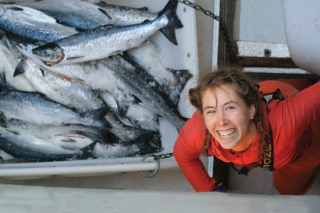
SWAP Meat Moves Seafood to the Forefront
27 January 2016Chef educators can influence what consumers eat tomorrow by introducing young culinarians to a Swap Meat concept today.
Courtesy of the Alaska Seafood Marketing Institute
Recently, the Alaska Seafood Marketing Institute (ASMI) encouraged chefs to replace beef, pork, lamb, or poultry with Alaska seafood. They did this by sponsoring the SWAP Meat for Alaska Seafood contest, which brought meat-based favorites to life with a sustainable twist – Alaska seafood as the protein.
Seafood is high in protein, essential vitamins and minerals, and low in saturated fat and calories. Its Omega-3 fatty acids are good for heart and brain health. These fatty acids occur almost exclusively in seafood and cannot be substituted by omega-3 fatty acid found in plants. And, eating seafood twice a week reduces the risk of dying from heart disease. Seafood is often a great protein choice for health-conscious consumers as well.
In fact, the World Health Organization, American Heart Association and the U.S. Department of Agriculture (USDA) recommend all adults should eat two 4 oz. servings per week.
Educators can use ASMI’s SWAP Meat approach as they teach students to swap in seafood for other traditional proteins. For example, students could move from chicken picatta to cod picatta or swap beef sliders for salmon sliders.
Chef Keoni Chang, Foodland Super Market LTD corporate chef, earned third place in the SWAP Meat contest for his recipe, Alaska King Salmon Filet “Oscar.” He swapped out traditional beef in favor of a wild Alaska salmon filet.

“I loved thinking about how to replace other proteins with seafood,” said Chef Chang. “I like working with wild Alaska salmon. The high fat content in the King salmon makes it easy to create a flavorful dish. And béarnaise sauce goes with everything.”
Click here for more information on contest winners and recipes.
Sustainability is also a huge initiative in all foodservice operations today. An important aspect of teaching students about seafood’s benefits resides in the environmental impact of raising the protein. Scientists say wild-caught seafood is very environmentally friendly with its low impact on the oceans as they do not use fertilizers, pesticides or antibiotics. Additionally, fishery managers and scientists manage the entire ecosystem not just fish stocks. They take into account the complex interactions of fish species, marine mammals, birds, and the health of the marine habitat as they make management decisions.
USDA Dietary Guidelines recommend that Americans consume at least 26 pounds of seafood annually, but the average consumer ate only 14.5 pounds in 2013. And, 67% of it was consumed outside the home. This statistic presents an opportunity for chef educators to teach students how to cook seafood and satisfy consumers already looking for this tasty protein when eating away from home.
Today, more chefs and consumers - those looking for an alternative to traditional meats - want to eat healthy foods without sacrificing flavor; they want to know the source of their food; and they want to feel good about their choices for the environment. Chef educators can help students answer these demands by including seafood in their instruction.
PHOTOS: Photos courtesy of the Alaska Seafood Marketing Institute.
